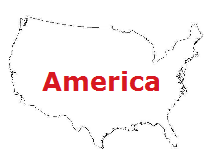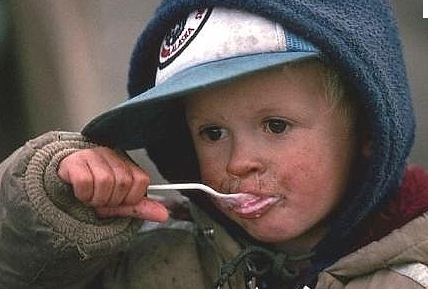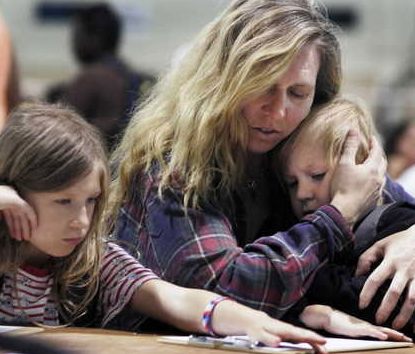|
Advertisements |
||
|
||
|
|
||
|
||
|
||
|
Hunger in America
|
The Basic Facts of Hunger in America.
An estimated 45 million people will wake up tomorrow hungry in this country. In the richest nation in the world, this can’t be tolerated. I am 62 years old, and when I was growing up it was expected that every American had the opportunity to get a proper education, find a field of endeavor, buy a good home, then to raise and feed a family. The sad fact is, that this dream is becoming just that, a dream. Millions of people are out of work, many for a year or more. Most of these people had good jobs paying decent wages at one time, but what work they can find now is in most cases, part time, and at low wages without benefits. Many have lost their homes, some live in the streets. Single mothers are having an especially hard time. So children are going to bed hungry, and many times their best meal of the day comes when they eat at school.
fact is, that this dream is becoming just that, a dream. Millions of people are out of work, many for a year or more. Most of these people had good jobs paying decent wages at one time, but what work they can find now is in most cases, part time, and at low wages without benefits. Many have lost their homes, some live in the streets. Single mothers are having an especially hard time. So children are going to bed hungry, and many times their best meal of the day comes when they eat at school.
The psychological toll this is taking can’t be measured. Malnourished children can’t study the way they should. Mothers are left devastated by seeing their children hopelessly looking forward to each meager meal, and never being without the feelings of hunger, even after having eaten. Fathers are left feeling as if they are inadequate providers. Drug use and alcoholism are taking their toll, and the children face a future, which is bleak at best. All of this not because people don’t want to work or feed their families well, but because our nation is broken…not just broke. There are people, who are able to live the American dream still, but fewer and fewer, and some of these want to believe that it is some how the fault of people who are simply lazy. After 62 years of living, working and observing, I know the truth. I am saddened, and broken hearted to see our nation torn apart by petty differences, when the fact is that our nation is in trouble, and it will take each and everyone of us to fix this mess that we are in.
There are people who are lazy, and down right criminal, who have lived off welfare, bilked the system and raised children who do the same. And at the other end of the spectrum, there is greed and criminality too. In the middle are the vast majority of Americans who are willing to work, to share, to make the best lives they can for themselves, and their families. We are mesmerized by spin doctors, and zealots from both sides. Each trying to do only one thing, and that is to hang on to their piece of the pie, and to gain as much more as they possibly can at the sake of those in the middle. While our children lay sleeping with empty bellies, the pied pipers of the left and right dance and play the same old songs day after day. The only answer that I can come up with, Is for people to wake up, really pay attention, think for themselves, educate themselves, let go of the greed, reach out a hand to others, and insist that the left and the right take things seriously before it is to late. Revolutions are born of hunger, and civil wars happen when those in power put us one against the other for their own selfish needs. Well fed, educated people can keep things from happening
Other Hunger Facts
In many ways, America is the land of plenty. But for 1 in 6 people in the United States, hunger is a reality. Many people believe that the problems associated with hunger are confined to small pockets of society, certain areas of the country, or certain neighborhoods, but the reality is much different.
Right now, millions of Americans are struggling with hunger. These are often hard-working adults, children and seniors who simply cannot make ends meet and are forced to go without food for several meals, or even days.
It’s time to educate ourselves about the causes of hunger in America.
Although related, food insecurity and poverty are not the same. Unemployment rather than poverty is a stronger predictor of food insecurity.
Poverty
In 2011, 46.2 million people (15.0 percent) were in poverty.
In 2011, 9.5 million (11.8 percent) families were in poverty.
In 2011, 26.5 million (13.7 percent) of people ages 18-64 were in poverty.
In 2011, 16.1 million (22.0 percent) children under the age of 18 were in poverty.
In 2011, 3.6 million (9.0 percent) seniors 65 and older were in poverty.
The overall Poverty Rate according to the Supplemental Poverty Measure is 16.0%, as compared with the official poverty rate of 15.1%.
Under the Supplemental Poverty Measure, there are 49.1 million people living in poverty, 2.5 million more than are represented by the official poverty measure (46.2 million).
Food Insecurity and Very Low Food Security
In 2011, 50.1 million Americans lived in food insecure households, 33.5 million adults and 16.7 million children.
In 2011, 14.9 percent of households (17.9 million households) were food insecure.
In 2011, 5.7 percent of households (6.8 million households) experienced very low food security.
In 2011, households with children reported food insecurity at a significantly higher rate than those without children, 20.6 percent compared to 12.2 %.
In 2011, households that had higher rates of food insecurity than the national average included households with children (20.6 percent), especially households with children headed by single women (36.8 percent) or single men (24.9 percent), Black non-Hispanic households (25.1 percent) and Hispanic households (26.2 percent).
In 2011, 8.8 percent of seniors living alone (1 million households) were food insecure.
Food insecurity exists in every county in America, ranging from a low of 5 percent in Steele County, ND to a high of 37 percent in Holmes County, MS.
Seven states exhibited statistically significant higher household food insecurity rates than the U.S. national average 2009-2011
United States 14.7%
Mississippi 19.2%
Texas 18.5%
Arkansas 19.2%
Alabama 17.4%
Georgia 17.4%
Florida 16.2%
North Carolina 17.1%
Use of Emergency Food Assistance and Federal Food Assistance Programs
In 2011, 5.1 percent of all U.S. households (6.1 million households) accessed emergency food from a food pantry one or more times.
In 2011, 57.2 percent of food-insecure households participated in at least one of the three major Federal food assistance programs –Supplemental Nutrition Assistance Program (formerly Food Stamp Program), The National School Lunch Program, and the Special Supplemental Nutrition Program for Women, Infants, and Children.
Feeding America provides emergency food assistance to an estimated 37 million low-income people annually, a 46 percent increase from 25 million since Hunger in America 2006.
Among members of Feeding America, 74 percent of pantries, 65 percent of kitchens, and 54 percent of shelters reported that there had been an increase since 2006 in the number of clients who come to their emergency food program sites.
FIVE Myths about hunger in America
My thanks to Robert Egger for this piece. Washington Post.
1
Hunger is supposed to happen in other places - in distant countries where droughts or storms or famine compel us to donate money and oblige our government to send relief workers and food aid. In reality, hunger also hits much closer to home.
According to a new report by the U.S. Department of Agriculture, 17.4 million American families - almost 15 percent of U.S. households - are now "food insecure," an almost 30 percent increase since 2006. This means that, during any given month, they will be out of money, out of food, and forced to miss meals or seek assistance to feed themselves.
Even those who get three meals a day may be malnourished. Americans increasingly eat cheap, sugary foods whose production is underwritten by government subsidies for the corn and dairy industries. As the New York Times reported this month, the USDA loudly promotes better eating habits while quietly working with Domino's to develop a new line of pizzas with 40 percent more cheese.
Obesity is related to hunger, too, thanks to our poor food choices and the lack of healthy food options in many communities. Many of us may be packing on the pounds, but they are life-threatening. According to the Centers for Disease Control and Prevention, more than 30 percent of adults are obese. The number of children who struggle with their weight is increasing, particularly among Latinos. Diet-related illnesses such as heart disease and diabetes are now on the list of the leading causes of death in America. We are dying not because we aren't eating, but because we're eating the wrong things.
Ending malnourishment is merely a humanitarian concern.
2
Hunger threatens our economic future and our national security. An astonishing one in four American children - close to 17 million - live in food-insecure homes. A kid who is hungry cannot learn. A kid who can't learn drops out of school. A kid without an education can't get a job and help America compete in a global economy. A kid without a job may turn to crime, get arrested and cost taxpayers $40,000 a year to sit in prison.
Those children who become obese adults, meanwhile, limit our armed forces' ability to protect our nation. Military officers recently warned that more than 9 million young adults - 27 percent of Americans ages 17 to 24 - weigh too much to enlist, shrinking the pool of candidates for service.
Meanwhile, more than 9 percent of medical spending, $147 billion annually, is devoted to treating obesity, and obese people spend $1,500 more per year on health care than people of average weight. The costs of poor nutrition help drag us further into debt and leave us vulnerable. America simply can't afford malnourishment anymore.
Children are the only ones who go hungry.
3
The person most likely to be hungry is a single, working mother. Federal programs ensure that low-income children can get free meals at school, but their mothers - many of whom are single and work low-paying jobs in the service sector - often have to make tough choices between food, rent, gas for the car, health care or new shoes for their kids. Millions of American women who face this predicament will feed their children and go without meals themselves.
Another tragedy in America is the rapidly growing number of seniors who have to choose between food, medicine and utilities. Though few of our elders will admit to needing help, a 2007 study by Meals on Wheels indicated that as many as 6 million are going hungry. Meanwhile, that free food-delivery service has waiting lists in many cities. The 80 million baby boomers approaching retirement are expected to live longer than any previous generation, but not all have set aside enough resources for their final years. When that silver tsunami strikes, hunger will come with it.
4
According to Jonathan Bloom's new book, "American Wasteland," up to 40 percent of the food we produce is ultimately thrown away. Much of it, such as household waste or decomposing fruits and vegetables, is unfit to eat or impractical to collect. Unnecessary expiration dates, particularly on canned foods, condemn millions of pounds of food to landfills. Logistically, we just can't feed everyone with leftovers.
Still, that doesn't mean we shouldn't use them. Since President Bill Clinton signed the Bill Emerson Good Samaritan Food Donation Act of 1996, initiatives around the country have retrieved millions of pounds of great food from restaurants and hotels and have used it to feed the hungry and provide culinary job training for the unemployed. Food banks have redistributed hundreds of millions of pounds of nonperishable items, and food activists called gleaners have taken to farms to forage for crops that won't make it to market.
Hunger is about food.
5
Ever since President Lyndon Johnson declared war on poverty in 1964, the government has worked diligently to ensure that no American goes hungry. For years, the USDA flooded communities with surplus commodities such as cheese and butter. Enrollment in the food stamp program (now called the Supplemental Nutrition Assistance Program), the front-line federal weapon in the fight against hunger, is at an all-time high, with 42.4 million people receiving support.
Yet the number of Americans who struggle to put food on their tables has never decreased. This is because hunger isn't about food. It's about jobs and wages.
The passage of living-wage laws, tariffs that protect U.S. jobs and comprehensive public health care - coupled with consumer support for businesses that pay good wages, reinvest in their communities or embrace green polices - would do more to combat hunger than anything charities have tried in the past five decades. Incentives for local food production would keep us healthy and our local economies thriving.

Home <> Western Gallery <> Western Dictionary <> Cowboys <> Reining
Western Store <>Western Writers <> Western Stars <> Western TV <> Country Music <> Guns <> Western Vacations





